How Long Can a House Go Without Gutters?
Author: Omar Alonso | Editor: Omar Alonso
Review & Research: Jen Worst & Chris Miller
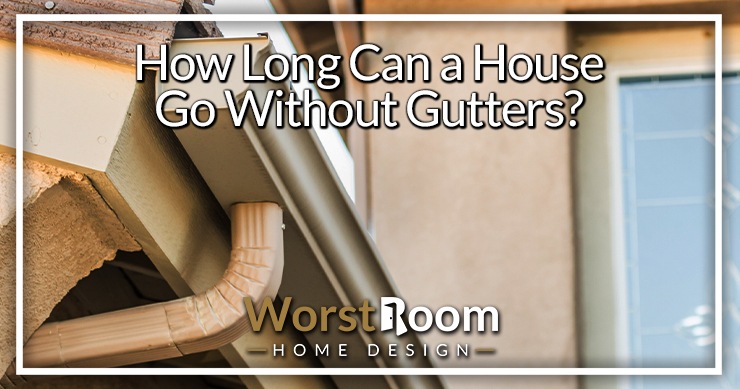
Did you move into a new home? If you have no experience as a previous homeowner, you might not make all the checks and balances when inspecting the house. One of the common things new homeowners miss are the gutters. So, how long can a house go without gutters?
If the house has no gutters, it can cause problems for the property down the road. The last thing you want is to shell out more money for home maintenance; it’s a frustrating experience. So, it’s a good idea to get those gutters in place.
But how long can you have no gutters on your house before there's a problem? Let’s look at this issue in detail and see how much lead time you have before things start causing issues.
What Are Gutters? Does My Home Need Them?
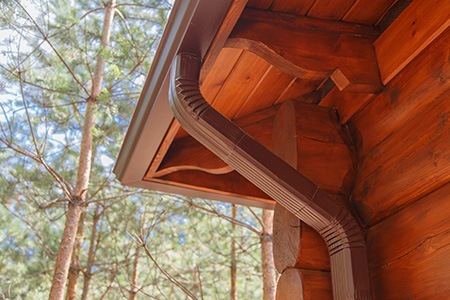
Yes. Your home needs gutters; they have a specific purpose vital to your property's longevity. Some buildings don’t have gutters, but they have other drainage systems that serve a similar purpose. The building code by the International Code Council (ICC) only introduced the "how to" but not "must do" code for gutters in the mid-1900s.
If your home was built before the 1940s, it might not have a gutter system. So, if that’s the case, why bother installing one anyway? After all, the house lasted eight decades without them, so why bother fitting them? You can find out when your house was built with these tips.
If you live in a dry area that doesn’t receive much rainfall during the year, you might get away with not installing them. However, if your property receives heavy seasonal rain, you’re placing the structural integrity of your home at risk.
If that’s the case with your property, there are strategies other than gutters you can implement on your property, providing a similar drainage effect to gutters. Some homes have a specific design to funnel the water away from dripping on areas that might cause structural damage to the foundations.
However, it’s always a good idea for most homes to install gutters to prevent the rain from causing problems. You may pick up problems like leaves blocking them and birds making nests in the gutters, but it's better than the alternative of damaging your home.
What Kind of Damage Occurs to a House With No Gutters?
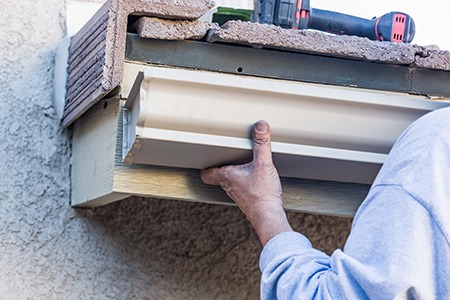
Gutters aren’t simply decorative. There are very legitimate reasons to push rain water into specific directions away from areas they can cause damage. Let’s look at what gutters prevent from occurring. Also, a gutter without a downspout is just as bad.
And back to the question of how long can a house go without gutters. None of these problems will pop up immediately. They may be unnoticeable until it's too late, though many will show signs along the way, telling you it's time to intervene.
Preventing Foundation Damage
If you don’t have gutters around your roof, the rain drips onto the ground around the home. The soil around the base of the house will absorb water and become sodden, with water pooling in some areas. These pools will create pressure on any types of house foundations, resulting in structural damage to the property.
If you have a basement in your home, this pressure accumulates and eventually leads to cracking in the basement walls. As a result, the water starts leaking into the basement, flooding the area. You end up with further structural damage, electrical hazards, and mold growing everywhere, presenting a health hazard.
Preventing Structural Damage
If you don’t have any gutters diverting rainwater, it flows in the opposite direction to the sides and walls of your home. High winds push the water around, increasing its velocity and erosion capability. As a result, it degrades the home's exterior, removing soil from the base of the walls.
When the water dries in the summer, you’ll notice the paint peels away, leading to chips and mold growth. The rising damp starts lifting the paintwork from the walls, leaving your home in a very unattractive state of disrepair.
The brickwork starts to crumble away, increasing the structural risk of the walls eroding away and reducing the load-supporting walls' ability to hold up the roof. As a result, you might find certain sections of the roof start to sag.
Prevent Landscaping Damage
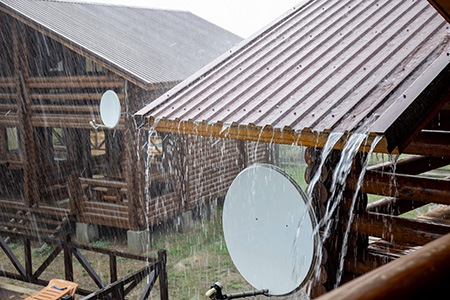
The gutters divert water away from the roof's edges to a specific drainage point on a lower level, pushing it away from important areas around the home. With no gutters in place, the water drips off all sides, and a heavy downpour can wreak havoc on your garden. This is the most obvious visual problem with having no gutters on your house.
It could wash away flowerbeds and water-log your lawn, resulting in the need for extensive landscaping repairs in the yard. It might seem that landscaping is affordable and no big deal. However, the costs of replacing a manicured lawn and extensive flowerbeds are astronomical.
Ice dams can form in the corners of your roof in the winter, and when they thaw, they lead to more property destruction to your landscaping and foundations. Installing gutters helps prevent these issues from occurring, and they’re more affordable than refitting your yard with a new garden or repairing the foundations.
Protecting the Exterior Siding
When heavy rainfall arrives in the early season, it washes all the debris collecting on your roof down to the base around your home. The shingles on your roof consist of compressed granules that come loose over time. The heavy rainfall makes these granules wash down the walls, resulting in staining.
You’ll notice long streaks starting at the roof and widening as they approach the base down your various types of siding. These stains make your home look unsightly, reducing its curb appeal and property value. The pooling water at the base creates mold, which creeps into the siding, staining it and rotting underneath the siding materials.
The rot creates holes in the siding, especially if you're using wood types of siding, and pests use these holes to access the cavities behind the siding, building their nests.
Minimize Your Home Maintenance Expenses
Every home requires maintenance, and adding gutters to your roof won’t change that. However, the gutters will significantly reduce your maintenance expenses over your home's lifetime. Gutters themselves require cleaning and minor seasonal repairs, depending on weather conditions.
However, these maintenance costs are far lower than the problems that arise from not installing gutters on your property. For instance, a flooded basement will cost a lot more to restore than installing and repairing gutters over the lifetime of your homeownership.
What Are the Signs I Need to Install Gutters on My Roof?
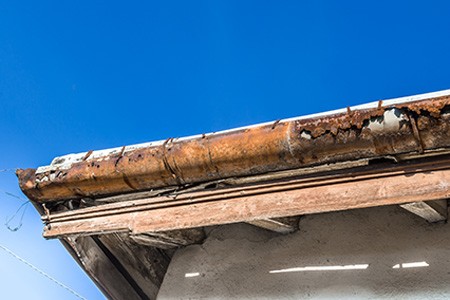
So, what are the signs that your home is already under duress? If you notice any of the following, it’s time to get those gutters on the roof as soon as possible. And you'll have an answer to how long can a house go without gutters.
Stained & Moldy Siding
If you have siding around your walls and you notice signs of mold or damp, it’s time to get some gutters. These problems might not be entirely visible initially, but they spread and become more apparent as the seasons pass.
Mold is a huge problem for any homeowner, lowering your property value while increasing health risks to you and your family. You’ll need to deal with it right away, or you will have huge problems coming in the future. Having no gutters on your house will make this problem very obvious on the siding, and you've probably already noticed it if you're here.
Flooded Basement
If your basement floods for the first time after a heavy downpour, don’t assume it’s a one-off event. It’s a sign that there may be structural problems with the walls and foundations, and you must take immediate action to resolve the issue. Leaving it will cost you a fortune in restoration and repairs to your property. If your sump pump runs constantly, that's a huge sign.
Trough Formation & Water Stagnation
If you notice troughs and dents in the ground around your home after heavy rainfall, it’s a sign water is pooling. As discussed, this pooling effect seeps into the ground, water-logging it and resulting in problems with the basement and foundations.
Don’t assume that because the water dried up that everything’s okay. The soil may appear dry, but the water table under the soil may be saturated, and you won’t even realize it. If the ground looks dry but feels soft underfoot, you’re asking for trouble if you don’t install those gutters right away.
Soil Erosion
Most buildings constructed in compliance with the building code have a slight slope facilitating the run-off of water from specific sides of the home. This design strategy prevents the foundations from being saturated after heavy downpours.
However, you’ll notice that the falling water from the roof erodes away the soil below it, resulting in divots forming around the area. This is even worse with a gutter without a downspout because it concentrates the impact in one spot. The water may run away to one side, creating a stream that washes out a stream leading to localized flooding in one area of your property.
What are the Types of Gutters to Fit Your Home?
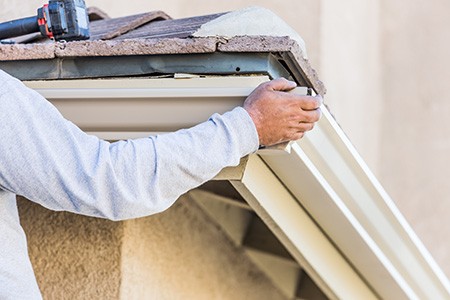
Now that we’ve convinced you about the need for gutters around your home, it’s time to look at the types of gutters available for your property. We have way more at that link, but for here you can primarily deal with two primary gutter systems available for homeowners, and we’ll unpack their differences for you right now.
Box-Style Gutters – These gutters are installed suspended under the roof shingles. They were typically installed in older houses before the advent of K-style gutter systems. These gutters usually feature construction with galvanized steel and require painting every few years.
K-Style Gutters – These are modern butter systems featuring a rigid structure. They’re durable and long-lasting, and most of them come in PVC materials doing away with the need for painting, like with the older box-style gutters.
There are plenty of other gutter styles featuring design and construction with a range of materials. Most modern gutters have PVC construction, but you can find options in aluminum, steel, and even copper. You also have options for seamless gutters to avoid leaking in joined sections on other systems.
So, How Long Can a House Go Without Gutters?
If you have an old home built in a dry area, you might get away without installing gutters on your property, though a house with no gutters is generally always a bad idea. However, newer homes built after 1950 will feature a gutter system, especially in areas experiencing seasonal rainfall.
There’s no direct answer to this question. How long can a house go without gutters? It depends on the landscaping, the type of siding used, how much rainfall is experienced, and so forth. But you know that every time it rains the damage is accumulating and ultimately you’ll have a real problem on your hands. This could be in a year or several years. I would prioritize getting gutters installed as soon as possible.



